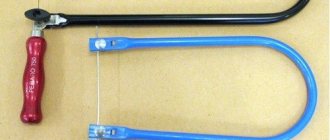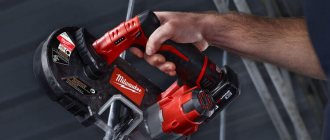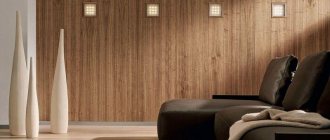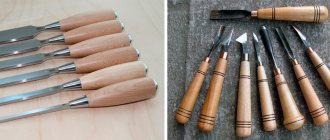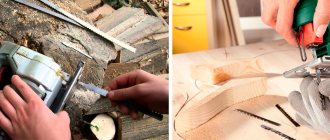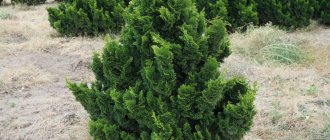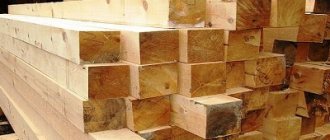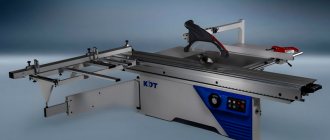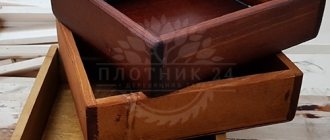Factors to consider
If you need to process a wooden surface, then you need to choose the optimal device to do it correctly; you should take into account several important criteria:
| Type of product being processed | It can be anything: load-bearing elements made of timber or logs, finishing made of lining, block house or boards, window and door blocks, furniture elements, decorative items and much more. Naturally, each type of product has its own optimal tool option, with which you can achieve the best quality of work with the least amount of time and effort. |
| Sanding quality | Another important factor, because in some situations it is necessary to smooth out large irregularities, and in others it is necessary to bring the surface to an ideal state. Therefore, before sanding wood, you need to stock up on the necessary consumables - discs or brushes with different grain sizes. |
| Scope of work | Smaller projects can be handled by hand, while larger projects will require the use of power tools, otherwise they can take weeks or even months to complete. If you decide to sand the wood yourself, the easiest way is to rent the necessary equipment; the price of this service is low. |
For large volumes of work, you will need a sanding cup for wood - its service life exceeds all other options tens of times
Disc sanders
Typically, disc sanders are used for finishing surface grinding. The working element of this technique is a flat rotating disk on which an abrasive material is fixed.
Disc grinders are divided into:
- Angle grinders (angle grinders) are well-known manual grinders, as well as specialized “boot” machines. The design of an angle grinder has one disk rotating parallel to the axis of the tool.
- Disc surface grinders are large units with 1-3 disks rotating around their own and central axes.
Disc surface grinders
Disc grinders are equipped with one or three disks onto which abrasive wheels are attached. The discs rotate around their axis and thereby “smooth” the wooden surface. This operating principle, combined with a floating seating of the discs, allows for high-quality polishing of the surface after pre-treatment with belt or drum machines.
Angle grinders (angle grinders)
Angle grinders are an alternative to expensive surface grinders when processing small surfaces, as well as in hard-to-reach places - under radiators, pipes, in corners and niches, near baseboards and walls. The working surface of an angle grinder is a flat disk onto which an abrasive tool is mounted.
The most affordable angle grinder is the grinder. For rough grinding, flap wheels can be used. They consist of a rigid base on which strips of sandpaper are attached in a circle. Fine grinding is best done using a rubber attachment for Velcro wheels (of different grain sizes).
“Sapozhok” is another manual angle grinder. Its shape resembles a boot with a flat base, under which a grinding disc is hidden. Thanks to this design, the “boot” is very convenient for treating areas located close to walls, places under radiators or pipes.
Random orbital sanders
Eccentric sanders
When processing a wooden surface, the sole of the eccentric sander moves in several directions: back and forth and around its axis. The quality of processing depends on the rotation speed and vibration amplitude. This type of equipment does an excellent job of grinding both smooth surfaces and curved parts. An eccentric sander can be used for fine sanding, polishing and cleaning of wooden parts.
You can use eccentric sanders at home and in professional activities, it all depends on the amplitude of the equipment’s vibrations, the power and the number of revolutions of the grinding surface. The most powerful machines: the vibration amplitude of the processing sole is not less than 7 mm and the power is 750 W, suitable for rough processing and characterized by high productivity.
Eccentric (or orbital) sanders, due to their circular motion path, allow you to achieve a perfectly flat and smooth surface.
Based on the method of attaching sanding sheets, machines are divided into two types: clamping and Velcro models. Machines equipped with a clip are slightly less expensive than similar models with Velcro. This is due to the fact that consumables for this type of equipment are easier to select and cost less. But changing the sanding sheet takes a little longer and is technically more difficult. Machines equipped with Velcro are much easier to use, but consumables are more expensive due to specific fasteners.
Professional and some household models of eccentric sanders are equipped with additional devices for dust removal: vacuum cleaners with dust collectors and a filtration system. Thanks to this, working with equipment becomes safer, since fine dispersed dust is very dangerous for the respiratory system.
Belt type machines
Belt sanders are designed for pre-grinding floors, leveling, stripping and sanding.
In appearance, a belt sander resembles a miniature crawler tractor. Its working surface is an abrasive belt glued into a ring, which moves between two rotating rollers, like on a conveyor. Tape width – 65-110mm. The sole on which the tape rests is made of a thin metal plate and complemented by a soft backing.
The rotation speed of the abrasive belt is in the range of 150-500 m/min. Productivity directly depends on this indicator. However, only if the additional speed is supported by increased power. Otherwise, it will not be possible to “press” the rapidly rotating belt to the floor and the increased speed will not improve the quality of the tool’s work. The optimal speed value - 300 m/min - is achieved with a power of 650-700 W.
To “press” the abrasive belt to the surface, the machine’s design is equipped with a metal platform of different sizes. Powerful professional models are equipped with a wide 100 mm sole, ensuring their high performance and stability on the surface. For a hobby class tool, a width of 75 mm is sufficient. Separately, it is worth mentioning the so-called “electric files” - machines with a very narrow working blade (width from 6 mm), allowing you to reach the most inaccessible places.
The technical characteristics and important features of working with belt sanders are described in the video (using the example of the Interskol LShM-76/900 model):
Making a grinder from a grinder
Many may say that the “grinder” is the same as an angle grinder, but there are some subtleties hidden here. It should be borne in mind that the angle grinder has very high speeds and often quite a decent weight. To polish a surface with a grinder, you need to have considerable experience in this matter and use special polishing discs and circles. The grinder has much lower engine speed and weight. To operate a factory grinding machine, no specific experience or skill is required.
You can independently make a good grinder from an angle grinder, which is not inferior in its parameters to a factory machine, only by modifying its electrical circuit, by installing the regulator at lower speeds and by using special grinding attachments.
Tips that will be useful when choosing
If you have decided on the optimal type of sander, then all that remains is to choose a specific model. To do this, the following tips will be useful to you:
- For home use, a professional expensive model is not needed. If you plan to use the sander once or periodically (to repair a surface, for example), then the optimal choice would be a hobby-class tool. High quality models are produced by Bosch, Skil, Sparky, Black&Decker, Interskol and Fiolent (Russian manufacturers).
- The weight and dimensions of the tool are of great importance. Especially if this tool is hand-held and you have to work with it while holding it in your hands. For small volumes, it is better to choose a less powerful, but more compact, lighter and faster model.
- Pay attention to ergonomics. It is necessary that you feel comfortable working with the tool. Look at where the switches are located, how easy (or difficult) it is to change abrasive materials, and whether the power cord will get in the way during operation.
- Test the machine right in the store. Turn it on and let it idle. This way you can assess the level of emanating noise and vibration.
- Visually inspect the machine. All parts of the housing must be precisely adjusted to each other. Eliminate any play in sliding elements.
- Ask the seller how easy a particular car is to repair.
- Ask about the range and cost of consumables (abrasive) materials.
Only after fully familiarizing yourself with these points can you make your final choice.
Hand-held sanders for wood processing have gained quite wide popularity among both home craftsmen and individual entrepreneurs who provide a variety of services that require high-quality woodworking.
Of course, the buyer is interested in purchasing the best wood sander and not overpaying a significant amount of money for meaningless characteristics. In this case, the rating we compiled based on real reviews from masters who have already used this technique will be very useful.
Currently, the following types of grinding machines are used for sanding wood and other materials:
- eccentric
- tape
- vibration
They all differ in design, functional parameters and, therefore, price.
What is a sander?
For the convenience of processing internal and external surfaces of wood, plastic, metal or stone, a special grinding machine is used. This power tool is designed to make the product smooth, that is, to reduce the roughness coefficient of its surface. The device is actively used in the process of car body repair, construction work, wall and floor repair, and furniture restoration. A grinding machine significantly speeds up manual labor and improves the quality of the work performed.
Wood brushing machine
Brushing is a method of artificially aging wood, which involves the use of specialized tools and techniques. The brushing technique is based on the mechanical processing of wood with special metal brushes, with the help of which the softest upper fibers of the material are removed.
Thanks to this technique, the hard surface of the wood is exposed, on which the texture of the material and the structure of the growth rings are clearly visible, and a beautiful relief is formed, emphasizing the aesthetic appearance of the finishing material. However, the brushing process does not end there.
To emphasize the relief and make the structure of the wood even more distinct, it is highlighted with a color that gives richness to natural shades.
To do this, the surface treated with a metal brush is unevenly painted, while the depressions formed as a result of the removal of soft fibers are painted in darker shades, and the surface texture is painted in lighter shades. Thanks to this technique, the wood relief becomes as noticeable as possible.
Important! In order for artificially aged wood to acquire maximum resemblance to a material that has aged in a natural environment, experts recommend painting the previously brushed material gray. Without waiting for the paint to dry completely, it is smeared from the relief surface.
The artificial structuring method can be used in the processing of both hard and soft wood. The main requirement that wood to be brushed must meet is the presence of a clearly defined texture and clearly visible layers of varying hardness.
Such materials include oak, pine, walnut, larch, wenge and ash.
As for alder, cherry, birch, teak, maple and beech, the brushing method will be proven to be ineffective for these species, since the distinctive feature of these trees is a fine-fiber structure without pronounced layering.
On a production scale, the amount of work is many times higher, and therefore there is a need to automate the process, which involves the use of special machines.
This helps simplify the work of producing aged wood, and also reduces time costs, allowing large volumes of work to be completed in a short period of time.
If you want to purchase special machines for brushing wood at home, it only makes sense if you plan to do a large amount of work. Let's look at the most common models of stitching machines.
Cleaning router or so-called brushing machine for brushing wood FESTOOL RUSTOFIX RAS 180.
- Three brushes are supplied with this device:
- The first steel wire brush used for primary wood processing;
- Second synthetic bristle brush for intermediate sanding;
- The third, made of sisal, is used to polish the treated surface.
The Makita 974 sander can also be used for sanding wood, however, while working with it, difficulties may arise associated with processing corner areas.
In this regard, at the joints between walls and floors, it is necessary to additionally use an angle grinder equipped with attachments.
The Felisatti AGF 110/1010E grinder can be used to process both relatively smooth and uneven surfaces. Metal and nylon brushes are supplied with this device.
It has an analogue - the Interskol sanding machine, which will make sanding wood much easier if you follow the instructions presented in our article.
What is sandpaper
Sanding paper is a combined material that consists of:
- The basis of sandpaper is most often paper or fabric.
- Abrasive is a grain that is applied to a substrate using glue or resin.
Manufacturing
Sandpaper production was first started in China in the 13th century. Craftsmen glued river sand of various sizes, crushed shell rock, and plant seeds to parchment using agar-agar or starch glue. Later they came up with the idea of using crushed glass as an abrasive, hence the appearance of “glass paper.”
Serial production of sandpaper began in London in 1833, then began to spread throughout the world, technology improved, and today we see a variety of types of this product.
Production stages:
- The paper base or fabric is impregnated with polymers, most often rubber latex.
- Glue heated to 30...50C is applied to the prepared base.
- The abrasive of the required fraction is applied using the bulk method.
- The semi-finished product is sent to the oven for drying. The temperature depends on the type of glue, grain fraction and other factors.
In this way, you can make low-quality sandpaper at home using thick cardboard, crumbs from an abrasive wheel or crushed glass, sand.
Release form
Finished products are stored by stacking sheets or rolling them into rolls. Sheet fabrics have sufficient rigidity, so they are difficult to bend. Sandpaper in rolls is more compact to store, its fraction and grain size are smaller than that of sheet sandpaper.
Other release forms:
- The abrasive mesh is a sparse sheet with fixed grain. When sanding, even the smallest dust particles pass through the material and do not become clogged in the pores. This working method is called “dust-free sanding”.
- Abrasive wheels are fine-grained sandpaper cut to the shape of attachments for mechanical devices. Its purpose is to clean the metal surface from rust and remove old coating.
- Sandpaper of different grits, cut to the shape of the attachment for power tools with Velcro fastening or to the holes made.
- Sanding belts intended for threading into sanding machines and machines.
Marking
Sandpaper markings indicate the fraction and concentration of the abrasive. Domestic GOST 3647-80 determines the number of grains of different sizes per 1 square unit, but this classification is considered outdated. Today, sanding paper complies with international ISO standards; this designation can be found on the back of the product. It should be noted that the data of the old GOST and the values of international standards overlap with each other. Their correspondence can be seen in the table.
The main difference between the old and new standards is the different movement of numbers in the markings:
- In GOST 3647-80, the values of grain size and density are reduced, which is quite logical;
- In the new ISO 6344 standard (GOST 52318-2005), the product number increases with decreasing value in the marking.
Decoding grain size
The letter "P" in the designation indicates the grain size. The larger the value behind the letter, the finer the skin fraction. P400 is a known zero. P600...P2500 have small fractions and an almost smooth surface; their grain size is not so noticeable to the touch. This type of sandpaper is used for final polishing in industry.
In the old GOST, things were different. Using 10-N as an example: the first number means that an abrasive of a size corresponding to a sieve with a mesh of 100 microns is applied to the surface of the product. The lower the indicator, the smaller the screening size.
Other designations
Types of sandpaper differ in the composition of the base and the properties of the grains. This information is also reflected in the product labeling.
- The letter “L” indicates the sheet form of the product. Rolled is not indicated in any way.
- The letter "M" stands for waterproof sandpaper.
- The product marked “P” is intended for grinding dry products without contact with moisture.
- “1” is an abrasive for soft surfaces, “2” is for hard surfaces.
To select emery for a certain type of work, you should take into account not only the main classification, but also the information provided, which is contained on the back of the sheet.
Application of orbital sanders
The operating principle of these tools is similar: grinding is carried out through light circular and oscillatory movements of the grinding surface with an amplitude of up to 5 mm. Sheets of sandpaper with different grain sizes are used as an abrasive material, secured to the sole using clamps or Velcro.
Orbital sander for wood
Vibratory sanders provide high quality processing and are used for grinding almost any materials: wood, plastic, metal, plaster and putty, as well as for removing corrosion products and old paint and varnish coatings.
The degree of processing depends on the amplitude of vibrations: for rough processing, an amplitude of 4-5 mm is chosen, for fine grinding - 1.5-3 mm. For household models, the rotation speed is usually adjusted in the range of 2000-5000 rpm, and the oscillation speed can be in the range of 25,000 per minute. The ability to regulate the eccentric amplitude, rotation speed and oscillations are very useful options for a VSM.
An important parameter is the power of the VSM; it is usually in the range of 150-600 W. The higher the power, the greater the productivity and continuous operation time of the tool. Another important factor determining the use of a VSM is the shape and area of the grinding pad. It can be square, rectangular or deltoid.
What to look for when choosing
In addition to the type of grinder, it is necessary to take into account basic technical parameters:
- Electricity consumption: from 110 to 600 W. It's worth noting that more efficient machines tend to use more electricity. For home, a 300 W option is suitable.
- The number of revolutions the sole makes: 6-25 thousand. Most often, slow instruments have high amplitude. Such models are used for rough processing. For finishing sanding, it is better to choose an electrical appliance with a higher speed.
- Amplitude: 1.5-5 mm. Shows how much the sole moves relative to the material with each movement. If you need a device for rough work, you should choose a device with the maximum value, and for fine finishing 1.5 -2.5 mm is suitable.
Random orbital sanders
An eccentric machine (ECM) operates on the principle of combining vibration and rotation. We can say that vibration and disc grinders are combined in one device. This combination results in excellent surface finish combined with high productivity. The working platform of the EShM is a round disk (“plate”).
Random orbital sanders are considered universal. They are suitable for both rough grinding (scraping) and finishing polishing for large volumes of work.
The thickness of the removed layer of wood can be adjusted by pressing harder or weaker on the platform. Performance can also be adjusted by changing the diameter of the vibration circle (eccentric stroke). The lower this indicator, the lower the productivity, but the better the processing quality. And vice versa. Therefore, for primary grinding, large vibration circles are installed on the machine, and small ones for final grinding (polishing).
Modern electric motors are characterized by a motor power of 200-900 W. More powerful models are also more productive. They are able to work with larger soles, up to 150 mm in diameter.
The adjustable rotational movements of the sander can be performed at speeds of 4000-14000 rpm. If there is no adjustment, then this figure drops to 12,000 rpm. The speed of oscillatory movements is approximately two times less. The higher the speed of the machine, the rougher the grinding can be, but the higher the productivity.
The size of the sanding pad is also very important for the job. The most popular grinders have a “plate” diameter of 115 mm, 125 mm and 150 mm. Usually the name of the tool already contains a number indicating the size of the sole. Large “plates” are designed to process large flat areas, so they are equipped with machines with high power and productivity. Sanding with a machine with a small "plate" will take longer, but it can accurately sand narrow and hard-to-reach areas.
Help in choosing can be provided by a video review where several grinders from different manufacturers were tested for professional suitability:
Best in the household series
Despite the shorter service life, the household series tool can process flat and curved surfaces. Perform rough and fine grinding of concrete, plaster, putty. Polish metal, plastic, glass, natural and artificial stone
KOLNER KRS 430 – the cheapest in its segment
The eccentric machine is used on wood, metal and plastic surfaces. Used for leveling plastered walls during home renovations. Polishes varnish and enamel coatings. Smooth speed control determines the required processing mode. Equipped with a dust removal system, which allows operations to be carried out indoors.
PROS
- Affordable price.
- Power.
- Low noise.
- Autonomous dust collector.
MINUSES
Does not perform fine polishing of the car body.
PATRIOT OS-125 – the lightest
The grinder will perform the stages of rough and fine processing of flat and curved surfaces. The low weight of the tool allows you to spend more time working without fatigue during the processing of a part. An effective dust extraction system concentrates waste into a removable dust container. The abrasive wheels are fixed with Velcro, which ensures a quick change of consumables.
PROS
- Lightweight - the hand does not get tired longer.
- Optimal power for home repairs.
- Effective cooling system - the electric motor does not overheat.
MINUSES
You have to hold the machine tighter - centrifugal forces tend to tear it out of your hands during the working process.
ENKOR MSHE-450/150E – the largest fluctuations
Works effectively during rough and medium grinding operations. Levels the plastered surface and smoothes the finishing putty. Removes old paintwork, rust, and scale from metal workpieces. The presence of an additional handle makes it easier to use.
PROS
- Increased diameter of the work plate.
- Long cord.
- Endurance.
MINUSES
- Ineffective dust collection system.
- The fixation of the sanding attachments fails quite quickly.
BOSCH PEX 300AE – the most productive
Tool for household use. Despite the classification, it allows dry sanding of wood, metal, and plastic. It is used for home repairs to remove old paint coatings, leveling plaster and putty. Dust emissions are mitigated by an effective microfiltration system.
PROS
- Allows you to perform a large amount of work.
- Doesn't get dusty.
- Equipped with an anti-vibration system.
MINUSES
- A bit noisy.
- Abrasive discs do not work evenly over the area.
ELITECH MSHE 0515E – the most powerful
The power of the electric motor is sufficient to perform operations such as grinding down convexities of plastered walls, smoothing the putty layer, and grinding the surface of ferrous and non-ferrous metals. Performs rough and finishing processing of wooden blanks. Connecting a vacuum cleaner allows you to keep your work area clean.
PROS
- Powerful electric motor.
- Work at a semi-professional level.
- Long cable.
MINUSES
An extra handle is missing.
Application of belt sanders
Belt sanders are used where it is necessary to quickly remove a fairly thick layer of material, for example, to sand an unplaned board or remove old paint from surfaces. LSMs are also used for precise fitting of parts and processing of the cut line.
The material is processed using an abrasive belt closed in a ring and stretched over rotating rollers. When moving, the tape removes a fairly thick layer of material, comparable to the work of an electric planer. The thickness of the removed layer depends on the grain of the abrasive belt.
When choosing a blade grinder, you need to pay attention to two parameters: the width and length of the abrasive belt used and its rotation speed. The area of the processed surface depends on the width, the aggressiveness and degree of processing depends on the speed.
The standard tape sizes for LSM are: 76x457 mm, 76x533 mm, 76x610 mm. The belt width of semi-professional sanders may be larger - 100 mm, but they are rarely used for household needs. The belt speed is usually in the range from 150 to 500 meters per minute, the power is from 400 to 1200 W. Useful functions include smooth control of the belt rotation speed and an automatic belt centering device, which prevents it from slipping off the rollers even during rotational movements.
Belt sander for wood
There are two types of abrasive belt for blades, with an abrasive layer of aluminum oxide or zirconium. Zirconium tape provides a deeper but more aggressive finish and promotes scratches that need to be treated with a less grainy tape. For processing metal surfaces, it is better to choose a zirconium tape; it can be used to sharpen cutting surfaces.
Surface processing using a belt sander is carried out as follows: place the machine on the surface to be processed without distortions, and, without putting pressure on the machine, make smooth longitudinal or circular movements along the surface of the material. If precise fitting of parts is necessary, grinding is carried out with short-term translational movements or using a bounding frame.
Types of grinding tools
Grinding machines come in different designs and operating principles. These factors depend on their purpose. The following types of sanders can be used to work with wood:
- vibratory grinding machine (VShM);
- belt grinder (LSM);
- delta grinder (DSM);
- eccentric (orbital) sander;
- brush grinder.
Vibrating sander
VShM is more often used for fine grinding or polishing of wooden surfaces. This tool is also suitable for removing coating material, varnish or paint. Grinding occurs due to oscillatory circular movements with a small amplitude. In some models, the speed of oscillation and amplitude can be adjusted. Sanding occurs with sheets or circles of sandpaper (whether the abrasive material is a sheet or a circle depends on the model), which are attached with Velcro or a clip.
Belt sander
LSMs are used for initial processing of wood materials, for example, to quickly remove the first layer when sanding or removing outdated paint . This type of sander is also suitable for precise fitting of furniture parts.
The LBM works on the principle of a plane: a circle-shaped belt rotates on rollers and, when pressed, polishes the wooden surface. The layer that is removed from the surface depends on the grain size of the tape. The higher the grain number, the more accurate and thinner the layer being removed.
Advantages of FSM
This type of sander has a number of advantages:
- processing of rough surfaces, it can be used even for unplaned boards, and you can immediately proceed to sanding;
- can be successfully used in hard-to-reach places, such as corners or curls in decorative items:
- precise fitting or trimming of parts along the marking line;
- using a blade, you can level the wooden surface or give it the desired shape;
- allows you to make a smooth rounding of elements.
Recommendations for selection
In order to choose a LSM, you must first decide for what purposes you will use it in the future. The main distinguishing factor of blade grinders is the classification of abrasive belts that are suitable for use with a sander. Minimal LSM options can work with tapes only 6.3 cm wide. Their advantage is that they are very light in weight and can be used with one hand. Larger brothers can work with belts up to 12 cm wide. They can be used to work on large areas. They are ideal for leveling. The best option for a home craftsman may be the option of a tape machine that works with a 760 mm tape.
The next parameter for choosing a LSM is the duration of its use. If you need it for light work, such as finishing small items or hobbies, then a simple inexpensive machine may be suitable for this. For construction, it is better to take a more serious option. Naturally, it costs more, but they, as a rule, do not wear out quickly and the proverb “The miser pays twice” comes in handy.
When choosing a LSM, you should also pay attention to its additional parameters:
- rotation speed adjustment;
- automatic centering of the belt (prevents the abrasive from flying off the rollers);
- dust collector
Delta grinder
This is a type of vibration grinding machine. It has the same principle of operation - vibration movements. The main difference between this type of grinding machine is the shape of the working element. It is shaped like a triangle or delta (hence the name). This machine can be used to sand corners or hard-to-reach areas such as recesses or protrusions.
Random orbital sander
The second name is orbital sander.
This tool is similar in operating principle to a VSM. The difference is that eccentric machines are more productive, grinding is more accurate and finer, and the principle of operation itself occurs due to the complex trajectory of the moving element. Grinding occurs with a disk with a diameter of 15 cm. Abrasive wheels of different grain sizes are attached to the disk using Velcro. Operating eccentric grinders
This type of grinding tools has a significant drawback: the formation of a large amount of dust. Manufacturers understand this and are working to improve the tools. Some models have dust collectors. This model can easily be used indoors. Therefore, if you plan to work indoors, it is better to take this into account when choosing and look for models with dust collectors.
Brush sander
The main difference between brush grinding tools is that the working part is not represented by sanding paper, but by a brush mainly made of metal. Therefore, such a tool is not suitable for grinding or polishing. It is used for removing coatings. The wood brush sander is designed to work on large areas, such as removing varnish from parquet, updating furniture or other large objects.
This type of grinding machine is also used to “aging” wood. With the help of a hard brush, the wood is given an ancient look, and such an element looks antique.
Kinds
Before choosing a wood sander, you need to familiarize yourself with the main types of devices.
Tape
It is recommended to buy such carpentry sanders for the first sanding of wooden surfaces. They are ideal for removing old layers of varnish or paint. Also, tape devices are often used to fit furniture parts.
Belt-type tools work on the principle of a plane. The circle-shaped tape rotates on special rollers. To start the sanding process, you need to press on it with a wooden product.
Orbital (palm)
When choosing a sander, you may encounter orbital devices. They can be divided into two main types.
Standard
Tape devices - most common models
It is recommended to buy such grinding machines for people who often have to work with uneven surfaces. Standard orbital models are suitable for processing sharp corners and flattened edges of wood.
These devices resemble tape devices. The only major difference is that grain paper is used instead of ribbons. Compared to belt sanders, orbital sanders are more versatile and multifunctional. Some consider them to be the best devices for sanding wood.
Random orbital
Another device that is often used for processing wooden products is random orbital CMMs. They differ from other models in the features of their work. Sanding is carried out using the installed sandpaper. It not only moves with the help of rollers, but also vibrates a little. Thanks to this, it is possible to clean even ribbed surfaces.
Detailed and multi-tooled
The best wood sanders include detail and multi-tool products. There are several varieties of such models.
File Sander
File Sander - universal polishing machine for polishing various materials
Quite often people hear the terms “finger sander” and “sander”, but do not know their exact meaning. These phrases are used to describe grinders that are equipped with a very narrow belt. With its help, it is possible to process even hard-to-reach places that cannot be reached using conventional CMM.
Such models are universal, as they can be used for sanding coatings made of:
- metal;
- wood;
- plastic;
- ceramics.
To process the above materials, you will have to use paper of different grain sizes.
Oscillating spindle
Oscillating spindles are often found in the ratings of grinding machines. This is a static tool that is equipped with a fairly long grinding drum.
Such CMM models are often used as tabletop tools. They are used for processing difficult angles, as well as curved surfaces. At the same time, the oscillating spindle is capable of sanding not only wood, but also metal.
Sander straight
Drum CMMs will help clean wood from glue, paint or varnish
Many people don't know which sander is best for smoothing straight edges. For such purposes, it is necessary to choose a straight sander. This tool will quickly smooth out all the edges and polish your plank floors or walls.
The main difference between this tool can be considered the features of its operation. During sanding, the sandpaper moves parallel to the grain. Thanks to this, it is possible to polish the edges of products much better. It also makes sanding ribbed surfaces easier.
Drum type sander
People are often interested in which sander is best for sanding wooden floors. A fairly popular tool that is regularly used in woodworking is the drum-type CMM. This device can be used to remove residual glue, paint or varnish. Also, with the help of such an angle grinder you can process surfaces made of plastic, metal and ceramics.
Rating of the best inexpensive wood sanders for the home in 2022
You can buy the best wood sander for home use from a range of units in the budget category. Inexpensive devices show good power, although they are inferior to professional models in reliability.
Interskol PShM-115/300E
A wood sander with a rectangular base should be chosen for sanding wide surfaces and smoothing outside corners. The vibration amplitude is 2.4 mm, the frequency can be adjusted. A dust container and sanding paper are supplied with the device; a vacuum cleaner can be connected to the unit.
You can buy an Interskol wood sander from 3,400 rubles Pros
- adjustment of the vibration frequency of the sole;
- reliable abrasive clamps;
- There is a lock on the start button.
Minuses
- makes a lot of noise;
- unreliable dust protection.
Hammer PSM 220 C
The grinder has a durable metal platform, holes for sawdust removal and a plastic dust container. It has a comfortable grip and makes up to 11,000 vibrations per minute. Powered by mains power, it does not tire your hands even with prolonged use.
The price of a Hammer PSM grinder starts from 3,000 rubles
pros
- weight 1.5 kg;
- thoughtful ergonomics;
- good top speed.
Minuses
- often breaks;
- The dust collection compartment emits a strong unpleasant odor.
Interskol PShM-32/130
A compact sander with a delta-shaped sole can be chosen for processing hard-to-reach and embossed surfaces. The attachments on the instrument are attached with Velcro. The device comes with a dust bag and two sanding belts.
Attention! The Interskol machine performs especially well when finishing wood with fine-grained abrasive attachments and at low vibration frequencies.
You can choose an Interskol sander for a price starting from 2,400 rubles.
Pros
- good grinding quality;
- weight less than 1 kg;
- Works for a long time without interruption, without overheating.
Minuses
- low-quality dust collector;
- requires frequent cleaning.
Main settings
Before choosing a tool, you need to understand its main characteristics.
- Power. The performance of the grinder depends on this parameter. The power of this tool ranges from 600 to 2500 W. The greater the power of the unit, the higher its quality indicators. They weigh more and cost an order of magnitude more. For simple woodworking, a grinding machine with a power rating of 600-800 W is suitable.
- Working surface area. This value affects the speed of work. The larger the working surface area, the faster it will be possible to grind the desired plane. Belt options have a smaller working surface, while vibrating ones have a larger one.
- Disc diameter. The diameter determines the area that can be processed at one time. This parameter also affects the finishing time.
- Additional equipment. Different models can be equipped with additional auxiliary elements.
- Additional handle. The handle helps to evenly distribute the load and reduce vibration. They are mostly two-position, less often three-position.
- Dust collector. Collects dust that is generated during operation of the mechanism. It can be either built into the unit itself or be a removable element on the side. There are replaceable and permanent options for dust collectors.
- Speed stabilizer. It can be used to control the rotation speed. The stabilizer allows optimal use of the grinding machine's performance.
- Speed controller. With its help, you can control and regulate the speed required for work.
- Case. A convenient way to store and transport tools.
- Battery. For autonomous use of the grinder, some models are equipped with a removable battery.
Drum type machines
A drum sander is a technique designed primarily for rough grinding. At the highest level, it also copes with sanding - removing the paint layer from parquet.
The operating principle of drum machines is based on the rotation of a cylindrical shaft (drum), “started” by an electric motor. An abrasive belt is installed on the shaft. When the drum rotates, it is pressed tightly against the wooden surface and “erases” a layer of the specified thickness from it (depending on the grain size of the abrasive on the belt). On average, during the grinding stage, a drum machine removes a layer of 1-1.5 mm from the surface. This is accompanied by the formation of wood dust and sawdust, which is why most models of drum machines are equipped with dust collectors.
The abrasive belts used for this type of sander are quite coarse - P24-40. Therefore, they cannot cope with polishing and after passing through a drum machine, they usually require modification by other types of machines (disc, vibrating, eccentric).
Any drum sander is a massive unit that moves on wheels. Weight can vary from 70 to 90 kg (on average). The smaller the weight (and therefore the dimensions) of the machine, the easier it is to operate, but its performance may be lower. If you have to work in an apartment, it is better to use a machine with less weight. For large production areas, larger units are more suitable.
Performance also directly depends on power. The average value is 2.2 kW. The greater the power, the stronger the mechanical impact on the surface. Moreover, such a machine can “pull” a large drum (with a wide and long abrasive belt).
How to cut a coffee grinder?
On the Internet, this topic is so “hackneyed” that you can get confused in the advice of “masters” on how to work with an angle machine correctly and safely: for yourself or for yourself?
This is because there are no generally accepted standards (scientifically validated by government experts) that are suitable for all types of work. Therefore, each experienced master confirms or denies different methods. As they say: there are as many people as there are opinions.
To avoid bad consequences, we will try to tell you the correct method based on the safety concepts and operating principles of angle grinders.
I’ll say right away that you can work for yourself or independently, both options will be correct if they are technically and safely observed.
On all grinding machines the spindle rotates clockwise.
- When we take the tool with our right hand and with our left hand by the additional handle, the disk rotates in our direction, which is called “toward ourselves.” In this case, you need to cut the coffee grinder yourself. Sparks will fly to the ground when the angle grinder is on its side. With this cut, the saw does not cling to the cutting edge, so it will not bite, clog or break.
- By moving the additional handle to the lower position, you, on the contrary, will work with a sander. The cutting blade will be facing in the opposite direction from you, making an “away from you” motion. This sawing technique is less convenient because you have to bend over to see the markings. Another feature of cutting on your own with a sander is that the movement of the tool will occur towards you. The sparks will be directed in the opposite direction. This method is mainly used by left-handed people.
Any of these methods of working with a sander is correct. Main
take precautions, do not cut the material against the “wool”
How to cut metal?
Metal is cut according to the principle described above
Let's explain some features to pay attention to:
- Sheet metal up to 3 mm. It can handle grinding machine power up to 1 kW and disc diameter 115-125 mm. On a thin surface, the wheel wears out faster due to the vibration of this material. To avoid this, place an extra board on the cutting line.
- For thicknesses from 3 mm, the grinding machine is more powerful and has a larger wheel diameter. You don't need to press the tool while cutting, the high speed will do everything for you. When working with a 250 mm diameter blade on thick workpieces, be careful not to twist it. Otherwise, you will get a curved section and a rupture disk.
Always ensure that the work piece or pipe does not pinch the saw. You must know exactly what will happen in the first second after you start cutting.
How to cut concrete and stone?
It is difficult to cut concrete, stone and brick because the cut is almost invisible due to the dust.
READ How to Use a Wood Sander
The first 10 cm will need to be cut blindly. Then, without turning off the sander, remove it from the cut and look at where the cut went.
Apply the included grinder to the cut, adjusting it to the cutting line. We look at the verticality of the disk and slowly draw it in the air above the cut line. If the sander is not warped, lower it to the edge of the cut and sink it slowly. The dust column forms again, so we continue to move “blindly” along the required mowing line, adhering to verticality and the desired angle. The deeper the cut, the tighter the machine should be sharpened.
If you do it right, you will feel the wedge before you hit. And you can even stop the impact by turning off the power and holding the crusher in the cut.
How to cut tiles?
Cutting tiles without chips is carried out using abrasive discs for stone. A diamond blade will cut faster, but will hit a lot. Can be used where a small incision is not required.
You need to cut the tiles using constant back and forth movements. You don't have to stay in one place (as you would when cutting metal or concrete) to prevent the tiles from melting and cracking.
Good tile cut. This is the correct choice of nozzle and precision in work. You can even cut hard floor tiles with an abrasive stone blade without chipping.
The best belt sanders
No. 5. BLACK+DECKER KA88
One of the budget belt sanders was presented by BLACK+DECKER. Its model KA88 has the following technical points.
- 720 W motor.
- Extremely slow, compared to others, constant speed of the belt - 250 m/min.
- Easy access to hard-to-reach places - just remove the protective cover.
- The large rear roller, and the leading one, does not slip.
- Adjustment of the front handle for a specific user.
- High-quality dust removal system.
- Do not mount in an upside-down position.
Due to the design features, it will take some time to get used to it. But in general, the device performs its tasks quite well.
pros
- Powerful motor.
- Little noise.
- Convenient access to parts of the device.
- Good dust removal.
- Belonging to the budget segment.
Minuses
- The lowest speed of the belt, and constant.
- You cannot attach the device to a workbench in an upside-down position.
BLACK+DECKER KA88
No. 4. BOSCH PBS 75 AE
Not only professional devices are found in belt variations of sanding machines. Amateur options also boast several good models. One of them is BOSCH PBS 75 AE.
Today it is already quite expensive, but you can close your eyes to this, knowing how good the device is. And he's really good.
The convenient location of the handles makes it easy to manipulate the machine when performing various tasks. More importantly, you can center the tape and secure the device to the top with the tape on the workbench.
Let's look at the technical specifications.
| Criterion | Description |
| Power | 750 W – this is exactly the power of this device from Bosch. |
| Tape size | Tape measuring 533 by 75 mm. It will ensure clear and stable operation of the device. |
| Belt speed | The maximum belt speed is 350 m/min. |
| Weight | Average weight – 3.5 kg. This weight will not tire you quickly, which is quite good. |
The only annoying mistake is that the seam of the dust collection bag splits, which is why dust can escape.
pros
- Convenient to take.
- You can attach the device to a workbench.
- The belt moves quite quickly, although in other models it moves even faster.
- Weight allows you to work on weight.
- Belonging to the budget segment.
Minuses
- The seam of the dust collector comes apart and eventually it breaks.
Reviews of the BOSCH PBS 75 AE grinder
No. 3. Makita 9403
The most brutal design that is suitable for a tough grinder is what a person immediately notices when they see the Makita 9403. In addition, this model has several remarkable features.
- 610x100 tape, which is not quite standard.
- Motor power is 1.2 kW, which is quite a lot.
- The constant speed of the belt (500m/min) is due to the absence of a speed controller.
- Heavy weight of the device (5.7 kg). For this reason, you need to be in good physical shape, because the device will be difficult to handle.
- The noise level emitted by the device is quite low.
- Due to the design of the grinding machine, vibration reduction is achieved.
Professionals who sand large horizontal surfaces will love this model. True, it is worth noting the rapid wear of graphite tapes, which will lead to their frequent replacement. And with a non-standard size of tapes this will be more difficult than usual.
pros
- It works fast.
- Simple design.
- High reliability and build quality.
- Powerful motor.
- Little noise.
- Reduced vibration due to design.
Minuses
- No speed controller.
- Graphite tape wears out quickly.
- Heavy weight of the device.
Makita 9403
No. 2. Makita 9404
Comparing the power and maximum belt speed of the Makita 9404 and DeWALT DWP352VS models, we can safely say that the first model will be faster and more productive than the second. This can be explained by the width of the tape, which is larger in Makita.
What also has a positive effect on productivity is the presence of a belt position stabilization system.
As a rule, people do not complain about Makita products, but this model still has one drawback - its graphite sole wears out too quickly. This is too bad for a professional device.
pros
- High level of productivity.
- Belt position stabilization system.
- The strength is quite high.
- Reliable and high-quality assembly.
- Normal price.
Minuses
- Somewhat non-standard tape size.
- The graphite tape wears out too quickly.
Makita 9404
No. 1. DeWALT DWP352VS
This model from the DeWALT company has its own interesting features that make this tool truly desirable. Let's take a closer look at them.
- The size of the tape is standard (533 by 75 mm), which allows you to replace it if necessary without any problems.
- Motor power is 1 kW, which is more than enough for rough and finishing processing.
- A large bag that collects all the dust.
- The heavy weight of the device is 5.5 kg, which makes it difficult to work with small parts, because you have to work on weight, and your hands get tired from the weight.
- The belt speed can be adjusted. The maximum speed possible on this device is 440 meters per minute.
- There are no rubber pads, which means vibration will be felt more strongly.
This device is an excellent choice for those who work with horizontal surfaces “above the roof”.
pros
- Easily replaceable tape format.
- The dust bin is quite large.
- Fast movement of the belt during operation of the machine.
- Extremely powerful motor.
Minuses
- The dust collector is located in an awkward position.
- There are no rubber pads due to which vibration is felt more strongly.
DeWALT DWP352VS
You might be interested in learning about the best construction vacuum cleaners. You can read about them in this article!
How to choose the right one based on your needs
Any hand-held electric tool has criteria that determine the parameters for its selection. For grinding machines, the general selection criteria are:
- Electrical power – the performance of the tool depends on it.
- The method of connection to the energy source (cord, battery), and if there is a cord, its length.
- Ease of use - depends on the type of materials used and finishing elements (rubber handles, handles, etc.), as well as the location of the handles on the product body.
- The weight of the tool – the mode of use depends on it, as well as the ability to work “in weight”.
- Availability of automation and protection systems - soft start and protection against short circuit currents.
- Possibility of adjusting speed modes - drive speed and abrasive tool speed.
- Possibility of connecting to a vacuum cleaner or dust storage container.
Using belt-type machines for grinding workpieces
When choosing belt-type models, in addition to the above criteria, you should pay attention to:
- length and width of the tape;
- type of belt centering mechanism (manual or automatic);
- presence of a brake;
- shape and the presence of an additional handle for ease of use.
When choosing orbital-type models, you need to pay attention to the following nuances:
- sole diameter;
- eccentricity value;
- presence of braking function.
Variety of types of wood sanders
When choosing vibration devices, you should pay attention to:
- shape and size of the sole;
- method of fastening the abrasive material;
- amplitude of the sole stroke.
Vibratory sanders
A vibrating sander is a compact universal tool used for coarse and fine sanding of various wooden surfaces, including parquet. During operation, the rectangular sole of the machine vibrates, making reciprocating movements of small amplitude at high speed. As the stroke amplitude increases, the grinding speed also increases, but the quality of processing decreases.
Sandpaper or an abrasive mesh of varying degrees of grain size is fixed on the base of the vibration sander. The paper can be secured with Velcro or with side clips. Metal clamps are used in most designs, as they allow sanding paper (mesh) of any manufacturer to be securely fixed to the soleplate.
The sole - the working element of vibrating grinders - can have different sizes. The most popular machines with traditional sole sizes (“standard”) are approximately 100x200 mm. But for narrow, hard-to-reach places, “mini” class units with dimensions of about 10x10 mm are more suitable.
Read also: How to fix headphones if one comes off
The platforms of most sanders are rectangular or square. Devices with a triangular sole belong to a separate class. They are designed for processing corners, elements of stairs, and surfaces of complex shapes. The triangular platforms of some models are rotatable and removable (for the possibility of installing another platform).
The base of the sole of budget models is most often steel or plastic, while for more expensive analogues it is made of aluminum or magnesium alloys. In any case, a high-quality sole is characterized by a small vibration amplitude when idling (without load). A soft pad made of rubber or fine-pored polymer is attached to the working surface of the sole. The polymer is denser than rubber, so it “holds” the plane better.
Most models of grinders of this type have a motor with a power of 150–300 W. They are lightweight, maneuverable, but at the same time do an excellent job of grinding. There are also more powerful machines, for example, Makita 9046 (600W). They are larger in size and weight, making them more difficult to handle. However, such machines have a significant advantage: they are able to work at low speeds without interruption (and overheating!) and obtain a higher-quality processing result.
The amplitude of the sole stroke of vibration machines is always small, ranging from 1-6 mm. 5-6 mm is the largest amplitude, allowing you to quickly sand the surface. But the processing will be quite rough. The smaller the amplitude, the better the grinding will be.
Another important characteristic is travel speed. At high speed, the machine is able to quickly remove a thick layer of wood. This corresponds to rough grinding. Finishing fine grinding is possible when using a machine at low speed. Many well-known manufacturers produce models with adjustable speed, which makes it possible to configure the tool for different processing purposes and for different materials.
A short overview to help you understand what to look for when choosing vibratory sanders:
Delta grinding
This is the same eccentric machine, but it looks like an iron. Just like in VSM, here, with the help of oscillatory movements, material is “selected” from the workpiece being processed. Almost all DShMs are equipped with dust collectors or connectors for connecting a vacuum cleaner. This Metabo FMS 200 can fit into any corner.
Delta sanders or renovators are designed for grinding and polishing hard-to-reach areas, such as internal corners or edges of complex profiles. This Metabo FMS 200 can fit into any corner.
This machine is also convenient for processing areas after decorative cutting of wooden furniture structures with a milling machine. This is a fairly highly specialized tool that is worth buying only if you often need to work corners. For the most part, VSM replaces this polishing “iron” quite well.

